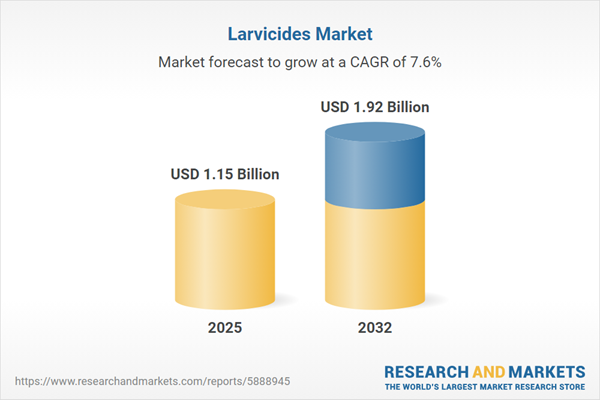Speak directly to the analyst to clarify any post sales queries you may have.
The larvicides market is experiencing significant transformation as regulatory updates, supply chain adjustments, and sustainability priorities directly reshape operational and compliance strategies. Senior decision-makers must leverage market intelligence to navigate evolving requirements and secure business growth in a rapidly shifting environment.
Market Snapshot: Larvicides Market Size, Growth, and Outlook
The global larvicides market is projected at USD 1.07 billion in 2024, anticipated to reach USD 1.15 billion in 2025, and estimated to approach USD 1.92 billion by 2032, reflecting a CAGR of 7.58%. Market momentum is driven by governments intensifying vector control initiatives, increasing pressure to meet compliance mandates, and a sector-wide push toward sustainable pest management solutions. Suppliers and service providers are refining their approaches to address a diverse client base, including professional users, municipalities, and private operators. The growing emphasis on integrated pest management is creating increased flexibility to adapt to regulatory fluctuations and address operational needs.
Scope & Segmentation: Strategic Breakdown of the Larvicides Market
- End User: Public health agencies oversee large-scale vector control, while property managers and hospitality organizations target outbreaks with tailored responses. Mosquito management companies, along with households, opt for professional and DIY applications. Agriculture and aquaculture focus on safeguarding crops and water systems. Commercial and industrial users aim to lower pest-related risks, supporting both compliance and workplace health.
- Product Type: Biological larvicides using Bacillus sphaericus and Bacillus thuringiensis israelensis enable environmentally responsible programs. Botanical options derived from neem and rosemary support organizational sustainability goals. Chemical larvicides—carbamates, pyrethroids, organophosphates, and insect growth regulators like methoprene and pyriproxyfen—offer broad-spectrum control and lifecycle management.
- Formulation: Available in granules, concentrates, suspensions, tablets, as well as floating and sinking pellets, these formats empower precise and context-specific applications across public health, agriculture, and urban sectors.
- Distribution Channel: Direct manufacturer supply and diversified distributor networks ensure adaptable delivery. Supplier partnerships extend to local agricultural outlets, hardware stores, pharmacies, and digital commerce, helping organizations manage seasonal and unpredictable increases in demand.
- Regions: The industry responds to dynamics in the Americas, EMEA, and Asia-Pacific, with market-shaping activity in countries such as the United States, Brazil, United Kingdom, Germany, Saudi Arabia, South Africa, China, and India. Regional complexity influences how stakeholders prioritize compliance, procurement, and deployment strategies.
- Companies Analyzed: Key players include BASF SE, Bayer AG, Corteva, Inc., Syngenta AG, Sumitomo Chemical Co., Ltd., ADAMA Agricultural Solutions Ltd., FMC Corporation, Valent BioSciences LLC, Clarke, Inc., and Marrone Bio Innovations, Inc. These companies invest in innovation, regional expansion, and technical support to advance standards and reliability in pest management solutions.
Key Takeaways: Strategic Insights for Senior Decision-Makers
- Organizations are shifting procurement practices toward biological and botanical larvicides, responding to both regulatory imperatives and sustainability commitments in pest control operations.
- Smart technology such as predictive analytics and geospatial mapping enables improved vector management, providing actionable insights for optimizing intervention timing and resource allocation.
- Supply chains are becoming more resilient through increased local sourcing, diversified supplier partnerships, and advancements in inventory flexibility, reducing risk from external shocks.
- Continuous product innovation, including advanced delivery systems and reformulation strategies, is essential for offering solutions that align with fast-changing regulatory requirements and industry needs.
- Developments in granule and pellet formulations allow users to tailor applications for distinct agricultural and urban contexts, improving operational outcomes and aligning with sector-specific demands.
Tariff Impact on Supply Chains and Cost Structures
Shifts in U.S. tariff policies are prompting larvicide producers to reevaluate sourcing models, leading to greater reliance on domestic raw materials and a heightened interest in biological and microbial alternatives to chemical inputs. These adjustments reduce exposure to global market fluctuations and bolster supply reliability, while stronger supplier relationships and selective backward integration strategies support cost stabilization and risk mitigation against currency or regulatory volatility.
Methodology & Data Sources
Research is grounded in an extensive review of peer-reviewed studies, regulatory documentation, patent analysis, and interviews with industry leaders and technical specialists. Scenario modeling is used to develop high-confidence forecasts, supporting informed decision-making for market stakeholders.
Why This Report Matters
- Actionable segmentation and regional insights assist organizations in anticipating regulatory trends and formulating robust market strategy.
- Procurement intelligence strengthens compliance readiness and helps ensure business continuity amid shifting standards and external disruptions.
- Technology benchmarking provides practical comparisons for aligning with emerging industry innovations and operational best practices.
Conclusion
Access to focused market intelligence empowers leaders to refine operational tactics, increase resilience to ongoing regulatory evolution, and maintain competitive agility in a dynamic larvicides sector.
Additional Product Information:
- Purchase of this report includes 1 year online access with quarterly updates.
- This report can be updated on request. Please contact our Customer Experience team using the Ask a Question widget on our website.
Table of Contents
3. Executive Summary
4. Market Overview
7. Cumulative Impact of Artificial Intelligence 2025
Companies Mentioned
The companies profiled in this Larvicides market report include:- BASF SE
- Bayer AG
- Corteva, Inc.
- Syngenta AG
- Sumitomo Chemical Co., Ltd.
- ADAMA Agricultural Solutions Ltd.
- FMC Corporation
- Valent BioSciences LLC
- Clarke, Inc.
- Marrone Bio Innovations, Inc.
Table Information
| Report Attribute | Details |
|---|---|
| No. of Pages | 182 |
| Published | November 2025 |
| Forecast Period | 2025 - 2032 |
| Estimated Market Value ( USD | $ 1.15 Billion |
| Forecasted Market Value ( USD | $ 1.92 Billion |
| Compound Annual Growth Rate | 7.5% |
| Regions Covered | Global |
| No. of Companies Mentioned | 11 |









